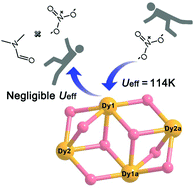Tetranuclear dysprosium single-molecule magnets: tunable magnetic interactions and magnetization dynamics through modifying coordination number†
Abstract
The study of mononuclear lanthanide-based systems, where the observed Single Molecule Magnets (SMMs) properties originate from the local magnetic anisotropy of the single lanthanide ion, has been extensively investigated in the literature. The case for polynuclear lanthanide SMMs becomes more challenging both experimentally and theoretically due to the complexity of such architectures involving interactions between the magnetic centers. Much interest was devoted to the study of the structural effect on the magnetic interactions and relaxation dynamics. However, the understanding of the structural influence on those two factors remains a difficult task. To address this issue, a system containing two structurally related tetranuclear Dy(III) SMMs, namely [Dy4(L)4(OH)2(DMF)4(NO3)2]·2(DMF)·(H2O) (1) and [Dy4(L)4(OH)2(DMF)2(NO3)2] (2) (H2L = 2-(2-hydroxy-3-methoxybenzylideneamino)phenol), is introduced and investigated. Through modifying the ligands on the changeable coordination sites, the intramolecular magnetic interactions and relaxation dynamics in these two Dy(III)4 SMMs can be tuned. Both complexes exhibit slow relaxation of their magnetization with a relaxation barrier of 114 K for complex 2 while a blocking temperature below 2 K is observed for complex 1. Ab initio calculations reveal that changes in coordination numbers and geometries on the Dy(III) sites can significantly affect the magnetic interactions as well as single-ion anisotropy. The combination of experimental work and ab initio calculations offers insight into the relationship between structures and magnetic properties and sheds light on the rational design of future polynuclear lanthanide SMMs with enhanced magnetic properties.



 Please wait while we load your content...
Please wait while we load your content...